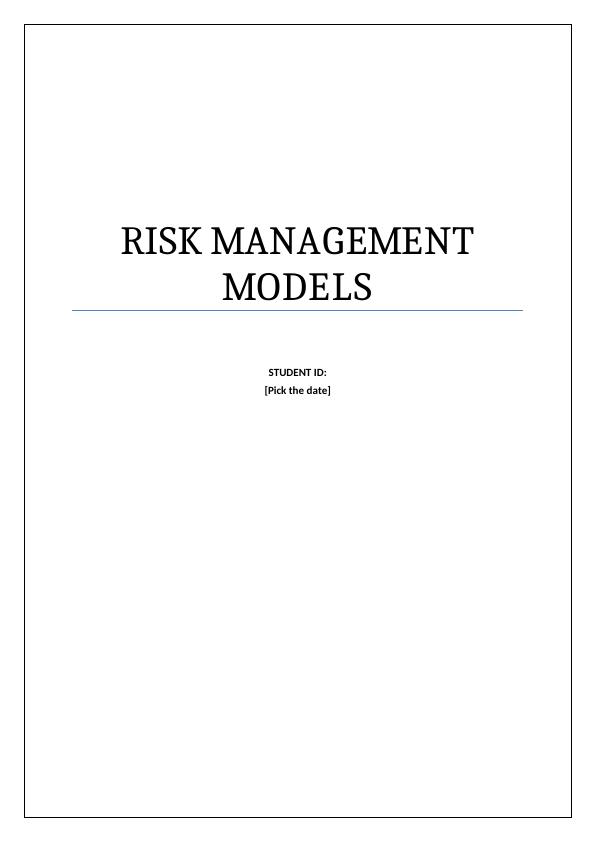Risk Management Models PDF
6 Pages940 Words87 Views
Added on 2021-04-16
Risk Management Models PDF
Added on 2021-04-16
ShareRelated Documents
RISK MANAGEMENTMODELSSTUDENT ID:[Pick the date]

TASK 1For evaluation of any given financial asset class, two aspects need to be consideredsimultaneously i.e. associated risk and returns. It is imprudent to expect that an investmentdecision could be made by analysing only one of the above aspects. From an investorperspective, the primary step for making investment decisions is to compute the associatedreturns and risk based on the historical or empirical data available. Also, it is noteworthy thathistorical returns may not be a good or reliable estimator of the future performance of theunderlying asset or project. Hence, it is required to identify the key risk elements goingforward which can impact the associated return with the asset under consideration (Parrinoand Kidwell, 2011).Then using the modelling techniques, the potential future scenarios need to be estimated andthe underlying returns in these different scenarios need to be projected. Further, numericalprobabilities need to be assigned to various scenarios so that a mean return could bedetermined on the asset. Based on the past and expected future variation in returns, the riskassociated with the underlying asset is determined. Also, it is noteworthy that riskmanagement techniques would also be need to put in place so as to ensure that the downsideis capped and the overall risk is reduced. This can be done through terminologies such asVAR or value at risk (Petty et. al., 2015). Risk hedging can be carried out with techniquessuch as diversification of portfolio. In diversification, the investor tends to invest in assetssuch that there is a natural hedge. As a result, if one basket of asset is underperforming thenthis could be compensated by the relative outperformance of the other asset class. Also, withregards to investing, it is critical that quantitative analysis is not limited to just measuring riskand returns at the time of making business decisions but as and when there is any significantchange, various models need to be run so as to estimate the change in intrinsic value of theasset. Based on this, suitable and timely exit should be planned (Northington, 2011).The use of descriptive statistics in making business and investment decisions ensures that thedecisions are objective and have firm basis which can be used to justify the investmentrationale if the need arises. Without adequate data analysis, there is a potential fear that thebusiness or investment decision may be driven by intuition or other biases which may resultin irrational decision making leading to losses. However, while statistical analysis withregards to risk and return is pivotal, it is imperative that qualitative factors must also beconsidered (Brealey, Myers and Allen, 2012).

Task 2a)The weekly returns of ASX 200 along with the allocated stocks have been computed in theexcel sheet attached. The relevant formula that has been used is listed below (Petty et. al.,2015).Weekly Returns (%) = [(Pt/Pt-1) -1]*100b)The requisite plot for returns is as indicated below.It is apparent from the above figure that volatility of weekly returns is quite low fromDecember 2016 to the present (i.e. February 2018). This is apparent from the value of weeklyreturns which have been capped within a small range of -1% to 2%. This is unlike the periodfrom June 2014 to November 2016 which has been quite volatile with wild swings in excessof 4% on weekly basis on either side. A period of low to moderate volatility has beenwitnessed for the period leading to March 2014. c)The requisite descriptive statistics related to returns are listed below.

End of preview
Want to access all the pages? Upload your documents or become a member.
Related Documents
Market Portfolio Theory and Capital Asset Pricing Modellg...
|11
|2719
|409
Financial Questions and Client Investments in Business Financelg...
|9
|2143
|458
ACC00716 Finance : Assignmentlg...
|4
|674
|45
Benefits And Limitations of Hedging Analysislg...
|8
|1533
|18
Modern Portfolio Theory and Risk Management in Financelg...
|5
|884
|53
Trade-off Between Risk & Return in Financelg...
|6
|1215
|44
